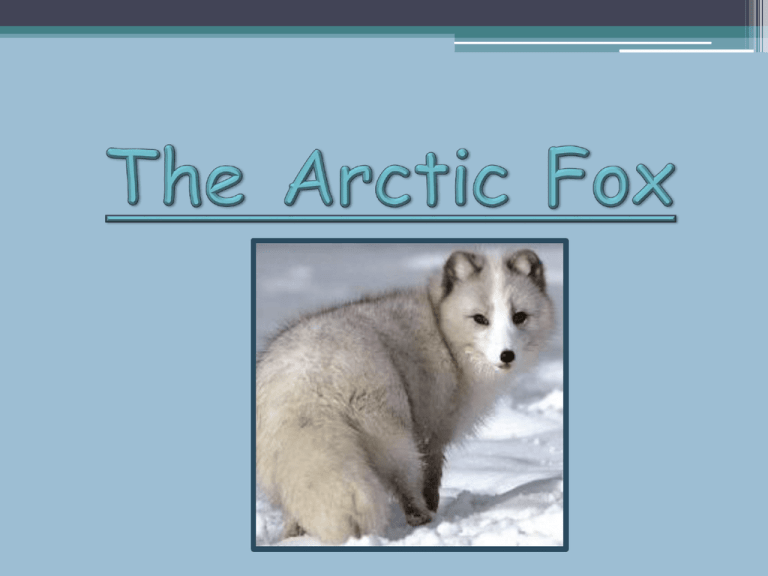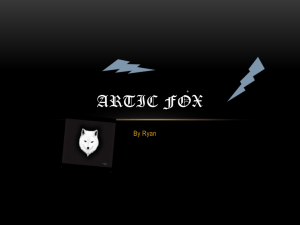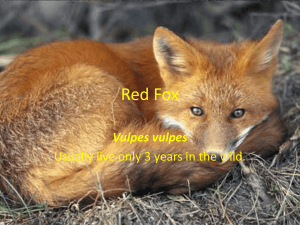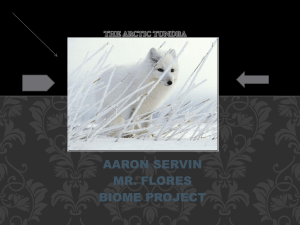Arctic Fox PowerPoint
advertisement

Vocabulary diurnal: animals who hunt and play during the day Characteristics of the Arctic Fox Hunts and plays during the day Usually only lives to age 3 or 4 Also known as the snow fox, polar fox, and white fox About as big as a pet cat The Arctic Fox Take a look at the Arctic fox’s skin underneath all that fur! Brown fur in summer White fur in winter Barks to communicate Short ears, mouth, and nose help keep the Arctic fox warm The Arctic fox is a member of the dog family July Summer Fox September During the summer, the Arctic fox’s fur is brown and gray and very thin. In September, its fur starts to grow thicker and changes color. The Arctic fox’s brown and gray summer fur helps it hunt during the summer. It blends in with the rocks and the dirt, providing the fox with camouflage so it can sneak up on its prey. Vocabulary camouflage: a way of hiding by blending in with the surroundings November Winter Fox By November, the Arctic fox’s fur is fluffy, white, and very warm. At the end of the winter, it sheds its fur and grows darker, thinner fur for summer. The Arctic fox’s white fur helps it hunt during the winter. It blends in with the snow, providing the fox with camouflage so it can sneak up on its prey. Vocabulary Brrrrr!!!! mammal: a warm-blooded animal with fur or hair and a skeleton; most mammals have 4 legs or 2 arms and 2 legs The Arctic fox must survive frigid temperatures during the winter. It has fur all over its body—even on the tips of its paws! The Arctic fox’s fur is so warm that it even sleeps outside during the winter. It uses its bushy tail as a blanket! If it gets too cold, the Arctic fox digs a hole in the ground to escape the freezing wind. Did you know that the Arctic fox has the warmest fur of any mammal? Time For Dinner!! The Arctic is not the place for a picky eater! The Arctic fox must work hard to find enough food to survive all year long. Of course, the fox prefers a nice, tasty lemming or vole, but it will eat just about anything it can find. That includes eggs, fish, berries, seaweed, and insects. The Arctic fox also eats Arctic hares, birds, seal pups, and leftovers from other animals. Arctic hare Seal pup Vocabulary The Arctic fox is an plants. omnivore, which means it eats both animals and The Hunt Is On! The Arctic fox must be a clever and skillful hunter if it is to survive in its frigid habitat. The fox can snatch birds, fish, and lemmings with one quick pounce. It uses camouflage to hide from its prey, sneaking up and attacking without warning. The Arctic fox uses it’s strong sense of hearing and smell to find and catch prey under the snow. Vocabulary habitat: the natural environment of a plant or animal When times are really tough, the fox will follow a polar bear, hoping to enjoy the leftovers from the bear’s dinner. But if the Arctic fox gets in the polar bear’s way, it’s goodbye fox! Watch this video of the Arctic fox hunting lemmings! Did you know the Arctic fox can run as fast as 30 miles per hour? That’s about as fast as the school bus goes! The Arctic fox’s speed helps it catch birds and other small animals. The geese scatter in every direction as the fox snaps its jaws at the frightened birds. After the Arctic fox catches its prey, it digs a hole and buries what it doesn’t eat right away. The Arctic fox will need this hidden food during the long, cold winter when food is scarce. Vocabulary These hidden food supplies are called caches. An Arctic fox gets ready to bury a stolen egg to be eaten during the winter. These eggs can last for up to one year! Arctic fox cubs stick close to home Family Time Notice how difficult it is to see the fox cubs because of their camouflage Arctic fox den Some dens have more than 100 entrances! In March or April, male and female foxes work together to clean out a den for their new kits. The kits are born in May or June and there are usually between 7 and 15 of them in a litter. The new kits are hungry and their parents spend a lot of time hunting for food for them. They have to catch as many as 100 lemmings a day for the family to survive! Did you know a male Arctic fox is called a reynard? Growing Up Fast When Arctic fox kits are first born, they are helpless. They are blind and depend on their parents for food. A mother fox, also called a vixon, and her kit Arctic fox kits are easy prey Golden eagle for predators like the golden eagle. Fox parents work hard to keep their new kits secret. Vocabulary predator: an animal that hunts other animals for food prey: an animal being hunted, caught, and eaten by another animal Young foxes learn to hunt through play. After about a month, the fox kits become curious and begin to poke their heads out of their den. By the time they are 2 months old, they are ready to begin hunting for their own food! Danger for the Arctic Fox The Arctic fox can become prey to predators like polar bears and wolves. The Arctic fox is hunted by trappers who catch foxes for their fur. Their fur is used to make hats, mittens, and coats. Approaching ANY wild animal in its natural habitat is NEVER a good idea! The Arctic Fox and YOU! While Arctic foxes are most often found in the wild, it is possible for people and foxes to spend time together just about anywhere and without anyone getting hurt! Biologists carefully study the Arctic fox to learn more about its habits. In towns in the Arctic, foxes can even be found living underneath houses during the summer! Some people raise Arctic foxes as pets—getting them as babies so they can train them the same way people train cats and dogs. Read this interview with one family who owns a pet Arctic fox named Swiper to see what it might be like to have one of your own! Q: What do you have to do to take care of your fox? A: Luckily enough, I found an astounding vet who was comfortable seeing Swiper as a patient. He’s like a furry, stinky dog. He needed to be microchipped, vaccinated, and given heartworm preventative medicine. I used to trim his nails personally, scoop his litter box and play with him. To do right by a fox, I could say he needed a lot of care. Q. Did he show any destructive habits, like chewing, digging, or tearing? What about marking, or “accidents”? A: All of the above. (except for marking). He loved to chew everything he could get his teeth on. His teeth are much sharper and more destructive than a normal dog… so he could destroy any toy within an afternoon! Pet foxes rely on you to keep them entertained. So when they get bored… you’ll be the one paying for it. Q: What does Swiper eat? Do you have fox food for him? Where can I buy some? A: He eats a mixture of dog and cat food. Trust me, it couldn’t get any better than that. Fox food does exist somewhere, but you don’t need to freak out about finding some. Most foxes aren’t picky eaters. Swiper seems to be a self-regulating animal, so we leave food in his cage at all times and just refill as needed. Pretty simple, am I right? Check out Balto, another pet Arctic fox, playing fetch with his owner! Arctic Foxes in North Carolina At CLAWS, a shelter near Chapel Hill, there are 2 Arctic foxes that live there: a male and female pair named Aurora and Borealis. They were donated to CLAWS after they were bought from a fur farmer. When they were bought, the farmer agreed to stop breeding foxes for their fur. The people at claws describe their fur as being less thick because they are not in their natural, very cold habitat. They are also described as being sneaky, clever, and foxy! You can see Arctic foxes at the North Carolina Zoo in Asheboro! CLAWS Asheville NC ZOO Glossary camouflage: a way of hiding by blending in with the surroundings cache: a hidden, often underground, supply of food diurnal: animals who hunt and play during the day habitat: the natural environment of a plant or animal kit: name for an Arctic fox baby mammal: a warm-blooded animal with fur or hair and a skeleton; most mammals have 4 legs of 2 arms and 2 legs omnivore: an animal that eats both animals and plants predator: an animal that hunts other animals for food prey: an animal being hunted, caught, and eaten by another animal reynard: name for a male Arctic fox vixon: name for a female Arctic fox










